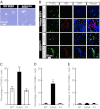Amyotrophic lateral sclerosis model derived from human embryonic stem cells overexpressing mutant superoxide dismutase 1
- PMID: 23197818
- PMCID: PMC3659703
- DOI: 10.5966/sctm.2011-0061
Amyotrophic lateral sclerosis model derived from human embryonic stem cells overexpressing mutant superoxide dismutase 1
Abstract
The generation of amyotrophic lateral sclerosis (ALS) disease models is an important subject for investigating disease mechanisms and pharmaceutical applications. In transgenic mice, expression of a mutant form of superoxide dismutase 1 (SOD1) can lead to the development of ALS that closely mimics the familial type of ALS (FALS). Although SOD1 mutant mice show phenotypes similar to FALS, dissimilar drug responses and size differences limit their usefulness to study the disease mechanism(s) and identify potential therapeutic compounds. Development of an in vitro model system for ALS is expected to help in obtaining novel insights into disease mechanisms and discovery of therapeutics. We report the establishment of an in vitro FALS model from human embryonic stem cells overexpressing either a wild-type (WT) or a mutant SOD1 (G93A) gene and the evaluation of the phenotypes and survival of the spinal motor neurons (sMNs), which are the neurons affected in ALS patients. The in vitro FALS model that we developed mimics the in vivo human ALS disease in terms of the following: (a) selective degeneration of sMNs expressing the G93A SOD1 but not those expressing the WT gene; (b) susceptibility of G93A SOD1-derived sMNs to form ubiquitinated inclusions; (c) astrocyte-derived factor(s) in the selective degeneration of G93A SOD1 sMNs; and (d) cell-autonomous, as well as non-cell-autonomous, dependent sMN degeneration. Thus, this model is expected to help unravel the disease mechanisms involved in the development of FALS and also lead to potential drug discoveries based on the prevention of neurodegeneration.
Figures





Similar articles
-
Human Cu/Zn superoxide dismutase (SOD1) overexpression in mice causes mitochondrial vacuolization, axonal degeneration, and premature motoneuron death and accelerates motoneuron disease in mice expressing a familial amyotrophic lateral sclerosis mutant SOD1.Neurobiol Dis. 2000 Dec;7(6 Pt B):623-43. doi: 10.1006/nbdi.2000.0299. Neurobiol Dis. 2000. PMID: 11114261
-
Redox system expression in the motor neurons in amyotrophic lateral sclerosis (ALS): immunohistochemical studies on sporadic ALS, superoxide dismutase 1 (SOD1)-mutated familial ALS, and SOD1-mutated ALS animal models.Acta Neuropathol. 2005 Aug;110(2):101-12. doi: 10.1007/s00401-005-1019-3. Epub 2005 Jun 28. Acta Neuropathol. 2005. PMID: 15983830
-
Knocking down metabotropic glutamate receptor 1 improves survival and disease progression in the SOD1(G93A) mouse model of amyotrophic lateral sclerosis.Neurobiol Dis. 2014 Apr;64:48-59. doi: 10.1016/j.nbd.2013.11.006. Epub 2013 Dec 19. Neurobiol Dis. 2014. PMID: 24361555
-
Oxidative stress, mutant SOD1, and neurofilament pathology in transgenic mouse models of human motor neuron disease.Lab Invest. 1997 Apr;76(4):441-56. Lab Invest. 1997. PMID: 9111507 Review.
-
Transgenic mouse model for familial amyotrophic lateral sclerosis with superoxide dismutase-1 mutation.Neuropathology. 2001 Mar;21(1):82-92. doi: 10.1046/j.1440-1789.2001.00361.x. Neuropathology. 2001. PMID: 11304046 Review.
Cited by
-
Dysregulated expression of death, stress and mitochondrion related genes in the sciatic nerve of presymptomatic SOD1(G93A) mouse model of Amyotrophic Lateral Sclerosis.Front Cell Neurosci. 2015 Sep 1;9:332. doi: 10.3389/fncel.2015.00332. eCollection 2015. Front Cell Neurosci. 2015. PMID: 26339226 Free PMC article.
-
Insights into Human-Induced Pluripotent Stem Cell-Derived Astrocytes in Neurodegenerative Disorders.Biomolecules. 2022 Feb 23;12(3):344. doi: 10.3390/biom12030344. Biomolecules. 2022. PMID: 35327542 Free PMC article. Review.
-
Direct Lineage Reprogramming Reveals Disease-Specific Phenotypes of Motor Neurons from Human ALS Patients.Cell Rep. 2016 Jan 5;14(1):115-128. doi: 10.1016/j.celrep.2015.12.018. Epub 2015 Dec 24. Cell Rep. 2016. PMID: 26725112 Free PMC article.
-
When glia meet induced pluripotent stem cells (iPSCs).Mol Cell Neurosci. 2020 Dec;109:103565. doi: 10.1016/j.mcn.2020.103565. Epub 2020 Oct 14. Mol Cell Neurosci. 2020. PMID: 33068719 Free PMC article. Review.
-
Modeling Neurological Disorders with Human Pluripotent Stem Cell-Derived Astrocytes.Int J Mol Sci. 2019 Aug 8;20(16):3862. doi: 10.3390/ijms20163862. Int J Mol Sci. 2019. PMID: 31398826 Free PMC article. Review.
References
Publication types
MeSH terms
Substances
LinkOut - more resources
Full Text Sources
Medical
Miscellaneous

